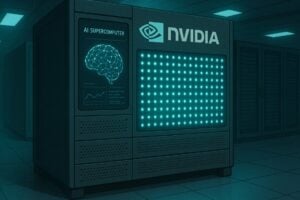For the first time in its history, Nvidia, the global giant of AI chips, will start the production of its own AI supercomputers directly in the United States. The announcement marks an important change of course for the company, which until today has entrusted the manufacturing of its processors to facilities located mainly abroad, particularly in Taiwan.
The new strategy includes an ambitious plan: up to 500 billion dollars in AI infrastructure produced on American soil over the next four years, with the support of U.S. industrial partners. This was stated by CEO Jensen Huang, who emphasized how domestic production will allow for “better responding to the enormous and growing demand for AI chips and supercomputers, strengthening the supply chain, and enhancing the resilience” of the production system.
A geopolitical context that accelerates Nvidia’s change of course
The decision comes at a particularly delicate time for international trade. In fact, the administration of President Donald Trump has emphasized manufacturing relocation in the United States, imposing tariffs on numerous products imported from traditionally allied countries. The tariff measures have proven to be particularly aggressive towards China, with a 145% tax, but also towards Taiwan, the country of origin of many Nvidia components, with a tariff set at 32%.
However, in an attempt to contain the effects on the domestic economy, chips, smartphones, computers, and other essential technological components have so far been exempted from tariffs. A move welcomed with relief by many companies in the sector, but it has not quelled concerns: rumors are circulating that, within a week, new tariffs on the import of semiconductors could be introduced.
Phoenix as the productive hub of Nvidia’s AI chips: the Blackwell take shape
The heart of the new Nvidia production will be Phoenix, Arizona, where the production of AI Blackwell chips has already begun. The work is carried out within facilities managed by the long-standing partner Taiwan Semiconductor Manufacturing Company (TSMC), one of the largest semiconductor manufacturers in the world and long associated with Nvidia for the fabrication of its graphic units.
The production area occupies over one million square feet of new spaces. This is complemented by agreements with two other companies: Amkor and Siliconware Precision Industries, both active in Arizona, which will respectively provide packaging and chip testing services.
Texas and “digital twin”: the future of production is robotic
In addition to Arizona, Nvidia will establish its facilities in Texas. Around the metropolitan area of Houston, new production facilities will be built in partnership with Foxconn, a Chinese giant based in Milwaukee. Near Dallas, Wistron, another major Asian supplier, will operate.
The goal is ambitious: to kick off mass production by next year. But Nvidia does not limit itself to traditional production. The company has announced that it will leverage its own technologies – particularly artificial intelligence – to create “digital twin factories”, where the plants will be virtually simulated and operated by special automated robots.
This innovation reflects a global trend already highlighted in the past: in 2017, the consulting firm McKinsey & Co. had estimated that by 2030, up to 800 million workers could lose their jobs due to automation. The new developments announced by Nvidia are moving exactly in this direction, accelerating the integration between intelligent machines and industrial production.
Arizona: epicenter of the American silicon valley
The focus on Arizona is not coincidental. For several years, the state has hosted significant investments in the technology sector. TSMC itself, for example, has launched a plan worth 40 billion dollars for the construction of two mega-factories, although the project has already faced delays and cost increases up to 100 billion dollars.
The arrival of Nvidia confirms this region as a new strategic hub for the semiconductor industry and artificial intelligence in the United States. A crossroads between growing domestic demand, geopolitical pressures, and technological innovation.
Silence on political motivations
Despite the announcement closely following the new tariff moves of the past Trump administration, Nvidia’s leaders did not want to openly comment on a possible link between the decision to relocate production and American trade policy.
However, the timing of the initiative suggests how industrial and fiscal policies may have significantly influenced the company’s choices, pushing towards a more stable, independent, and geographically diversified production structure.
An investment of half a trillion: Nvidia bets on the USA
With 500 miliardi di dollari in nuovi impianti and a growing network of production partnerships on American soil, Nvidia positions itself at the forefront of developing a new national technological infrastructure for AI. From physical factories to digital twins, through increasingly powerful chips, the company bets everything on innovation, autonomy, and resilience.
In an era of crisis in global supply chains and commercial uncertainties, Nvidia marks a turning point for the U.S. technology sector, establishing itself as a leading player in building the future of artificial intelligence directly in the heart of America.


